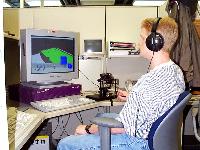 FLIGHT's User Interface is an innovative combination of a 3D windowing system and haptic feedback in a craft metaphor. It utilizes 3D inputs and 3D feedback to make the interface intuitive.
FLIGHT's User Interface is an innovative combination of a 3D windowing system and haptic feedback in a craft metaphor. It utilizes 3D inputs and 3D feedback to make the interface intuitive.

Our sense of touch is the only human sense that is bi-directional, in that it can be used to affect the world as well as sense it. Haptics therefore can be essential to intuitive interactions in a 3D computer generated environment.
FLIGHT incorporates force feedback into its interface and interaction. It uses the PHANToM· Haptic Interface to actually touch what a user sees on the screen including the 3D windowing system, the control panel, and even application specific data.
FLIGHT has the ability to spatialize 3D sounds in a 3D environment. Sounds seem to originate from virtual objects in the same way that they do in real life using HRTF (Head Related Transfer Function) technologies.
With the use of 3D sound, users in a collaborative environment can hear where objects are in the environment, focus specifically on what they want to, and even communicate and hear each other's voices from their respective avatars.
 FLIGHT's User Interface is an innovative combination of a 3D windowing system and haptic feedback in a craft metaphor. It utilizes 3D inputs and 3D feedback to make the interface intuitive.
FLIGHT's User Interface is an innovative combination of a 3D windowing system and haptic feedback in a craft metaphor. It utilizes 3D inputs and 3D feedback to make the interface intuitive.
The interface allows access to a variety of navigation techniques, 3D tools, and control modules, and gives an intuitive interaction strategy between interacting with data and interacting with the system itself. The entire interface is 3D which is essential to the future of 3D computer generated environments.
The current research for the FLIGHT software is to design a computer animation system. This includes a variety of modelling and animation techniques that take advantage of the 3D feedback, inputs, and interface.
Because the system has force feedback and does not use the mouse, interactions are more natural and can mimic strategies that people are comfortable with such as 3D sculpting, painting, or tools such as a lathe, router, planar, etc. Users will also have access to advanced animation techniques. This type of interface can revolutionize the way people interact with computers.
Another significant area of research will be to add a computational intelligence to the system. This will include voice recognition, speech synthesis, and intelligent control and interaction.